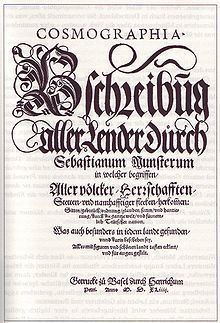Originally published 1544 | ||
 | ||
Similar Geography, Theatrum Orbis Terrarum, Nuremberg Chronicle, De sphaera mundi, Atlas Maior | ||
The Cosmographia by Sebastian Münster (1488–1552) from 1544 is the earliest German-language description of the world.
Contents
It had numerous editions in different languages including Latin, French (translated by François de Belleforest), Italian, English, and Czech. The last German edition was published in 1628, long after his death. The Cosmographia was one of the most successful and popular books of the 16th century. It passed through 24 editions in 100 years. This success was due to the notable woodcuts (some by Hans Holbein the Younger, Urs Graf, Hans Rudolph Manuel Deutsch, and David Kandel). It was most important in reviving geography in 16th-century Europe.
His earlier geographic works were Germania descriptio (1530) and Mappa Europae (1536). In 1540, he published a Latin edition of Ptolemy's Geographia with illustrations.
Contents
As late as the 1598 edition, the content consisted of:
Book I - Astronomy, Mathematics, Physical Geography, CartographyBook II - England, Scotland, Ireland, Spain, France, Belgium, The Netherlands, Luxembourg, Savoy, Trier, ItalyBook III - Germany, Alsace, Switzerland, Austria, Carniola, Istria, Bohemia, Moravia, Silesia, Pomerania, Prussia, LivlandBook IV - Denmark, Norway, Sweden, Finland, Iceland, Hungary, Poland, Lithuania, Russia, Walachia, Bosnia, Bulgaria, Serbia, Greece, TurkeyBook V - Asia Minor, Cyprus, Armenia, Palestine, Arabia, Persia, Central Asia, Afghanistan, Scythia, Tartary, India, Ceylon, Burma, China, East Indies, Madagascar, Zanzibar, AmericaBook VI - Mauritania, Tunisia, Libya, Egypt, Senegal, Gambia, Mali, South Africa, East Africa